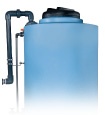With all of the uses for polyethylene, there are many companies and plants that need rotationally molded products not currently offered by manufacturers. Thankfully, working with a specialist to build a custom built solution is a viable option in order to manufacture a unique product that meets your exact specifications.
Topics:
Value Added
Recently, a chemical storage spill occurred at a Roanoke metals processing plant. A forklift punctured a storage tank containing hydrochloric acid. This pungent liquid is a strong, highly corrosive acid that creates toxic and potentially fatal fumes. Because of the high-risk chemical involved, the plant was quickly evacuated. Thankfully, the spill was less than 100 gallons and could be contained with minimal impact on the plant production schedule, and most importantly, no one was injured.
Topics:
News and Customer Stories
The popularity of craft brewing is exploding across the United States. To date, over 3000 craft breweries exist. Smart, flexible, cost-effective storage of the dry ingredients, water, and cleaning agents and chemicals used in the brewing process is essential.
Topics:
Applications
In locations where chemical storage tanks are subject to earthquakes and heavy winds, tank restraint systems are critical. A proper tank restraint system prevents the tank from sliding or tipping over. Tank restraints prevent against damage to the tank itself, and a potential costly environmental cleanup from a spill.
Topics:
Fittings and Accessories
Safe storage of chemicals is vital. In a previous article, we recommended a comprehensive annual chemical storage tank inspection to detect cracking and crazing, gasket and fitting issues,and several other points on and around the tank that could develop into potential problems.
Topics:
Value Added
NSF/ANSI Standard 61 (NSF-61) is a set of national standards that relates to water treatment. It establishes stringent requirements for the control of equipment that comes in contact with either potable water or products and chemicals that support the production of potable water.
Topics:
Value Added
The traditional choice for storing the materials in making beer is stainless steel. Process engineers and major breweries are beginning to realize the array of benefits polyethylene tanks offer.
Topics:
Applications
Poly Processing takes special care to ensure it is in compliance with ASTM D1998 standards. In the third piece of our Top 15 Questions to Ask Your Tank Manufacturer, we take a brief look at some common questions regarding verification.
Topics:
Value Added
Over the course of the next few months we will be covering The Top 15 Questions to Ask Your Tank Manufacturer. In this first installment of this series we will be covering a question we frequently receive about the ASTM D1998 testing standards and how tank manufactures test their tanks.
Topics:
Value Added



